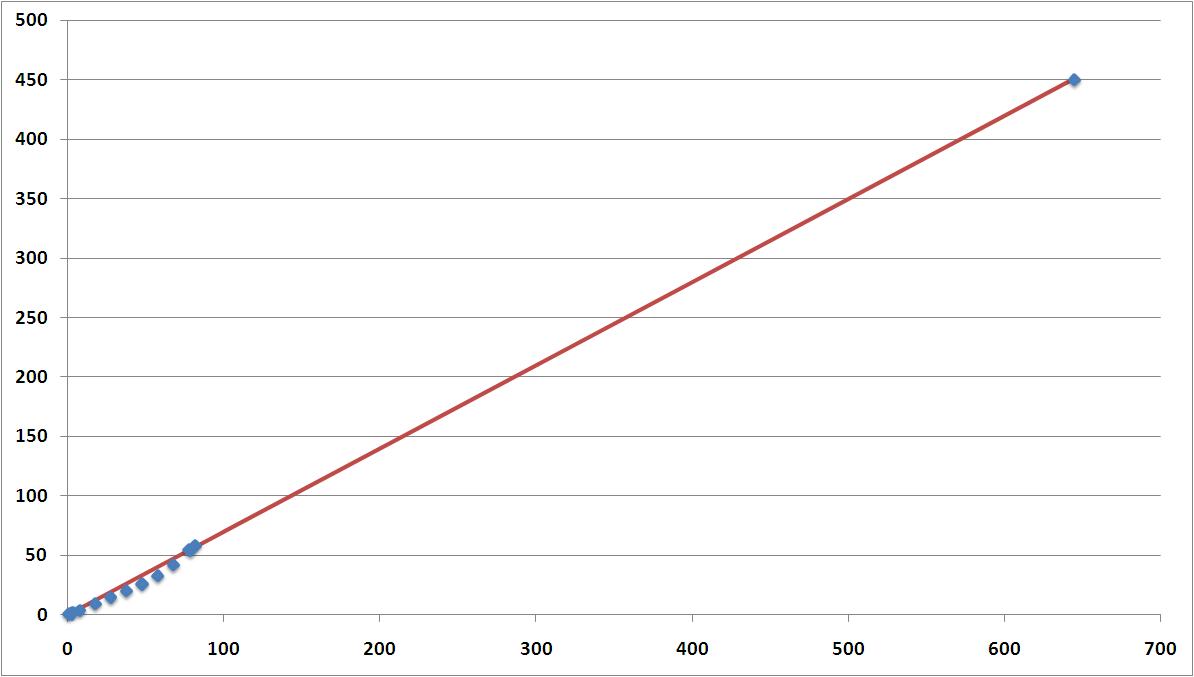It was explained in part 1 that absolute positions 1 to 82 give a linear rotation speed (from 0 to about 50°/s), and position 83 a high rotation speed (450°/s for z, 200°/s for rz).
Following chart gives the rotation speed for a given virtual position of z that goes from 0 to 645. That gives a linear speed from 0 to 450°/s. Virtual positions from 83 to 644 have to be created.

Red line is obtained with a simple linear regression.
Each mouse packet applies a rotation speed over a time that is the inverse of the mouse frequency (for ex 100Hz => 10ms).
A rotation speed for a virtual position between 83 and 644 may be generated “in average”.
For example, if a speed of 450°/s is applied (virtual position 645=real position 83) over 5ms, and 0°/s is applied (real position 0) over 5ms, the average speed that is obtained over 10ms is 225°/s (virtual position 321).
0+83 makes crappy movements, that technique actually works great with 82+83
I realized afterward that it is similar to PWM.

How did you measured that ?
Simple but painful: apply a stick position, count rounds, divide by the elapsed time.
order atorvastatin 20mg generic atorvastatin 20mg tablet lipitor 40mg canada
buy cipro online cheap – bactrim over the counter order amoxiclav without prescription
ciprofloxacin 1000mg sale – buy trimethoprim generic purchase amoxiclav for sale
buy generic flagyl – purchase terramycin pills azithromycin drug
ciplox generic – tindamax us erythromycin 500mg tablet
valacyclovir 1000mg for sale – order starlix 120mg without prescription zovirax 400mg generic
ivermectin 6 mg pills – buy generic ceftin 250mg tetracycline cheap
order metronidazole 400mg generic – order cleocin 300mg for sale azithromycin medication
order ampicillin buy doxycycline sale how to get amoxicillin without a prescription
purchase lasix – candesartan cost buy capoten generic
buy glycomet 500mg – buy lincocin 500 mg online cheap oral lincomycin
purchase retrovir – roxithromycin 150 mg for sale allopurinol cost
order clozaril generic – frumil 5mg us brand famotidine
seroquel 50mg uk – buy quetiapine pill cheap eskalith for sale
order hydroxyzine sale – buy buspirone 5mg without prescription buy endep 10mg online cheap
order clomipramine for sale – buy duloxetine 40mg pills buy generic sinequan online
amoxicillin oral – buy amoxicillin medication buy cheap generic cipro
amoxiclav usa – baycip generic cost ciprofloxacin
cleocin 150mg cost – buy vantin 100mg sale chloramphenicol cost
azithromycin 500mg tablet – sumycin online buy how to buy ciprofloxacin
cost albuterol – purchase allegra online cheap theophylline 400mg brand
fda ivermectin – order doxycycline order cefaclor capsules
buy clarinex generic – buy generic triamcinolone over the counter order albuterol 2mg inhaler